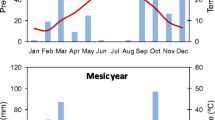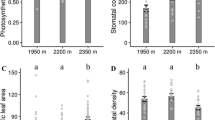Abstract
Although phenotypic plasticity of morphological and physiological traits in response to drought could be adaptive, there have been relatively few tests of plasticity variation or of adaptive plasticity in drought-coping traits across populations with different moisture availabilities. We measured floral size, vegetative size, and physiological traits in four field populations of Leptosiphon androsaceus (Polemoniaceae) that were distributed across a rainfall gradient in California, USA. Measurements were made over 5 years that varied in precipitation. We also conducted a growth chamber experiment in which half-sibs from three populations were divided equally among a well-watered and a drought treatment. We tested for selection on traits in each of the watering treatments, and evaluated whether traits exhibited plasticity. In the field, plant traits exhibited substantial variation across populations and years. Flower size, leaf size, and water-use efficiency (WUE) were generally higher for populations that received greater average rainfall. However, in dry years, we observed a decrease in flower and leaf size, but an increase in WUE across the populations. In the growth chamber experiment, leaf and physiological traits exhibited plasticity, with smaller leaves and higher WUE found in the drought, as compared to the well-watered treatment. Only specific leaf area exhibited differentiation in plasticity among populations. Although there was no observed plasticity in floral size, selection favored smaller flowers in the drought treatment and larger flowers in the well-watered treatment. Our results suggest that moisture availability has led to trait variation in L. androsaceus via a combination of selection and phenotypic plasticity.



Similar content being viewed by others
References
Agrawal AA, Erwin AC, Cook SC (2008) Natural selection on predicted responses of ecophysiological traits of swamp milkweed (Asclepias incarnata). J Ecol 96:536–542
Anderson JT, Inouye DW, McKinney AM, Colautti RI, Mitchell-Olds T (2012) Phenotypic plasticity and adaptive evolution contribute to advancing flowering phenology in response to climate change. Proc R Soc Lon B 279:3843–3852
Aspelmeier S, Leuschner C (2004) Genotypic variation in drought response of silver birch (Betula pendula): leaf water status and carbon gain. Tree Phys 24:517–528
Baythavong BS (2011) Linking the spatial scale of environmental variation and the evolution of phenotypic plasticity: selection favors adaptive plasticity in fine-grained environments. Am Nat 178:75–87
Bell CD, Patterson RW (2000) Molecular phylogeny and biogeography of Linanthus (Polemoniaceae). Am J Bot 87:1857–1870
Bradshaw AD (1965) Evolutionary significance of phenotypic plasticity in plants. Adv Genet 13:115–155
California Irrigation Management Information System (CIMIS) (2012) Website http://wwwcimis.water.ca.gov. Accessed 15 June 2012]
Carroll AB, Pallardy SG, Galen C (2001) Drought stress, plant water status, and floral trait expression in fireweed, Epilobium angustifolium (Onagraceae). Am J Bot 88:438–446
Caruso CM (2006) Plasticity of inflorescence traits in Lobelia siphilitica (Lobeliaceae) in response to soil water availability. Am J Bot 93:531–538
Caruso CM, Maherali H, Sherrard M (2006) Plasticity of physiology in Lobelia: testing for adaptation and constraint. Evol 60:980–990
Couso LL, Fernandez RJ (2012) Phenotypic plasticity as an index of drought tolerance in three Patagonian steppe grasses. Ann Bot 110:849–857
Dawson TE, Mambelli S, Plamboeck AH, Templer PH, Tu KP (2002) Stable isotopes in plant ecology. Ann Rev Ecol Syst 33:507–559
Donohue K, Messiqua D, Pyle EH, Heschel MS, Schmitt J (2000) Evidence for adaptive divergence in plasticity: density- and site-dependent selection on shade avoidance responses in Impatiens capensis. Evol 54:1956–1968
Donovan LA, Dudley SA, Rosenthal DM, Ludwig F (2007) Phenotypic selection on leaf water- use efficiency and related ecophysiological traits for natural populations. Oecologia 152:13–25
Dudley SA (1996a) Differing selection on plant physiological traits in responses to environmental water availability: a test of adaptive hypothesis. Evol 50:92–102
Dudley SA (1996b) The response to differing selection on plant physiological traits: evidence for local adaptation. Evol 50:103–110
Edwards CE, Ewers BE, McClung CR, Lou P, Weinig C (2012) Quantitative variation in water- use efficiency across water regimes and its relationship with circadian, vegetative, reproductive, and leaf gas exchange traits. Mol Plant 5:653–668
Elle E, Hare JD (2002) Environmentally induced variation in floral traits affects the mating system in Datura wrightii. Funct Ecol 16:79–88
Elle E, Gillespie S, Guindre-Parker S, Parachnowitsch AL (2010) Variation in the timing of autonomous selfing among populations that differ in flower size, time to reproductive maturity, and climate. Am J Bot 97:1894–1902
Feild TS, Chatelet DS, Brodribb TJ (2009) Giant flowers of Southern magnolia are hydrated by the xylem. Plant Phys 150:1587–1597
Franks SJ (2011) Plasticity in drought avoidance and escape in the annual plant Brassica rapa. New Phyt 190:249–257
Fraser LH, Greenall A, Carlyle C, Turkington R, Friedman CR (2009) Adaptive phenotypic plasticity of Pseudoroegneria spicata: response of stomatal density, leaf area and biomass to changes in water supply and increased temperature. Ann Bot 103:769–775
Galen C, Sherry RA, Carroll AB (1999) Are flowers physiological sinks or faucets? Costs and correlates of water use by flowers of Polemonium viscosum. Oecologia 118:461–470
Ghalambor CK, McKay JK, Carroll SP, Reznick DN (2007) Adaptive versus non-adaptive phenotypic plasticity and the potential for contemporary adaptation in new environments. Funct Ecol 21:394–407
Gianoli E (2004) Plasticity of traits and correlations in two populations of Convolvulus arvensis (Convolvulaceae) differing in environmental heterogeneity. Int J Plant Sci 165:825–832
Gianoli E, Gonzalez-Teuber M (2005) Environmental heterogeneity and population differentiation in plasticity to drought in Convolvulus chilensis (Convolvulaceae). Evol Ecol 19:603–613
Goodwillie C (1999) Multiple origins of self-compatibility in Linanthus Section Leptosiphon (Polemoniaceae): phylogenetic evidence from internal-transcribed-spacer sequence data. Evol 53:1387–1395
Goodwillie C, Ness JM (2013) Interactions of hybridization and mating systems: a case study in Leptosiphon (Polemoniaceae). Am J Bot 100:1002–1013
Gugger S, Kesselring H, Stöcklin J, Hamann E (2015) Lower plasticity exhibited by high-versus mid-elevation species in their phenological responses to manipulated temperature and drought. Ann Bot 116:953–962
Herrera J (2005) Flower size variation in Rosmarinus officianalis: individuals, populations and habitats. Ann Bot 95:431–437
Heschel MS, Rignios C (2005) Mechanisms of selection for drought stress tolerance and avoidance in Impatiens capensis (Balsaminaceae). Am J Bot 92:37–44
Heschel MS, Donohue K, Hausmann N, Schmitt J (2002) Population differentiation and natural selection for WUE in Impatiens capensis (Balsaminaceae). Int J Plant Sci 163:907–912
Heschel MS, Sultan SE, Glover S, Sloan D (2004) Population differentiation and plastic responses to drought stress in the generalist annual Polygonum persicaria. Int J Plant Sci 165:817–824
Holm S (1979) A simple sequential rejective method procedure. Scan J Stat 6:65–70
Ivey CT, Carr DE (2012) Tests for the joint evolution of mating system and drought escape in Mimulus. Ann Bot 109:583–598
Kearns CA, Inouye DW (1993) Techniques for pollination biologists. University Press of Colorado, Boulder
Kelly JK, Holeski LM, Arathi HS (2008) The genetic correlation between flower size and water use efficiency in monkeyflowers. Evol Ecol Res 10:147–152
Kenney AM, McKay JK, Richards JH, Juenger TE (2014) Direct and indirect selection on flowering time, WUE (WUE, δ13C), and WUE plasticity to drought in Arabidopsis thaliana. Ecol and Evol 4:4505–4521
Lambrecht SC (2013) Floral water costs and size variation in the highly selfing Leptosiphon bicolor (Polemoniaceae). Int J Plant Sci 174:74–84
Lambrecht SC, Dawson TE (2007) Correlated variation of floral and leaf traits along a moisture availability gradient. Oecologia 151:574–583
Lambrecht SC, Santiago L, DeVan CM, Cervera JC, Stripe CM, Buckingham LA, Pasquini SC (2011) Plant water status and hydraulic conductance during flowering in the Southern coastal sage shrub Salvia mellifera (Lamiaceae). Am J Bot 98:1286–1292
Lázaro-Nogal A, Matesanz S, Godoy A, Pérez-Trautman F, Gianoli E, Valladres F (2015) Environmental heterogeneity leads to higher plasticity in dry-edge populations of a semi- arid Chilean shrub: insights into climate change responses. J Ecol 103:338–350
Maherali H, Caruso CM, Sherrard ME, Latta RG (2010) Adaptive value and costs of physiological plasticity to soil moisture limitation in recombinant inbred lines of Avena barbata. Am Nat 175:211–224
Mal TK, Lovett-Doust J (2005) Phenotypic plasticity in vegetative and reproductive traits in an invasive weed, Lythrum salicaria (Lythraceae), in response to soil moisture. Am J Bot 92:819–825
Matesanz S, Gianoli E, Valladares F (2010) Global change and the evolution of phenotypic plasticity in plants. Ann New York Acad Sci 1206:35–55
McDowell SCL, Turner DP (2002) Reproductive effort in invasive and non-invasive Rubus. Oecologia 133:102–111
Mitchell-Olds T, Shaw RG (1987) Regression analysis of natural selection: statistical inference and biological interpretation. Evol 41:1149–1161
Nicotra AB, Davidson A (2010) Adaptive phenotypic plasticity and plant water use. Funct Plant Biol 37:117–127
Nicotra AB, Hermes JP, Jones CS, Schlichting CD (2007) Geographic variation and plasticity to water and nutrients in Pelargonium australe. New Phyt 176:136–149
Patiño S, Grace J (2002) The cooling of convolvulaceous flowers in a tropical environment. Plant, Cell Environ 25:41–51
Raven PH, Axelrod DI (1978) Origin and relationship of the California flora, vol 72. University of California Publications in Botany, Berkeley
Schlichting CD, Levin DA (1990) Phenotypic variation in Phlox. III. Variation among natural populations of P. drummondii. J Evol Biol 3:411–428
Sherrard ME, Maherali H (2006) The adaptive significance of drought escape in Avena barbata, an annual grass. Evol 60:2478–2489
Suárez LH, Pérez F, Armesto JJ (2011) Strong phenotypic variation in floral design and display traits of an annual tarweed in relation to small-scale topographic heterogeneity in semi- arid Chile. Int J Plant Sci 172:1012–1025
Sultan SE, Bazzaz FA (1993) Phenotypic plasticity in Polygonum persicaria II. Norms of reaction to soil moisture and the maintenance of genetic diversity. Evol 47:1032–1049
Teixido AL, Valladares F (2014) Disproportionate carbon and water maintenance costs of large corollas in hot mediterranean ecosystems. Perspect Plant Ecol Evol Syst 16:83–92
Thein SJ (1979) A flow diagram for teaching texture by feel analysis. J Agron Edu 8:54–55
Valladares F, Sanchez-Gomez D, Zavala MA (2006) Quantitative estimation of phenotypic plasticity: bridging the gap between the evolutionary concept and its ecological applications. J Ecol 94:1103–1116
van Kleunen M, Fischer M (2005) Constraints on the evolution of adaptive phenotypic plasticity in plants. New Phyt 166:49–60
Via S, Lande R (1985) Genotype-environment interaction and the evolution of phenotypic plasticity. Evol 39:505–522
Western Regional Climate Center (WRCC) (2012) Website http://www.wrcc.dri.edu. Accessed 15 June 2012
Wu CA, Lowry DB, Nutter LI, Willis JH (2010) Natural variation for drought-response traits in the Mimulus guttatus species complex. Oecologia 162:23–33
Xu Z, Zhou G (2008) Responses of leaf stomatal density to water status and its relationship with photosynthesis in a grass. J Exp Bot 59:3317–3325
Acknowledgements
The authors thank J. Detka, I. Graeve, D. J. Hughey, L. Rosengreen, and A. Shores with help in the field and the lab. We also thank L. Bonachea for assistance with statistical analyses. Comments from D. States greatly improved the manuscript. Funding was supported by the Department of Biological Sciences of San Jose State University, by San Jose State University Graduate Studies and Research, and by the Howard Hughes Medical Institute Undergraduate Education Program Grant #52006312.
Author information
Authors and Affiliations
Corresponding author
Additional information
Communicated by William E. Rogers.
Rights and permissions
About this article
Cite this article
Lambrecht, S.C., Morrow, A. & Hussey, R. Variation in and adaptive plasticity of flower size and drought-coping traits. Plant Ecol 218, 647–660 (2017). https://doi.org/10.1007/s11258-017-0718-x
Received:
Accepted:
Published:
Issue Date:
DOI: https://doi.org/10.1007/s11258-017-0718-x




